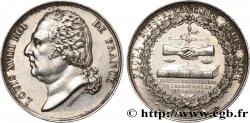Obverse
Obverse legend : LOUIS XVIII ROI - DE FRANCE.
Obverse description : Tête de Louis XVIII à gauche.
Reverse
Reverse legend : PACTA SUBSCRIBENTIBUS LEGES SUNT - CHAMBRE DES NOTAIRES DE L'ARRONDISS. DE VERSAILLES.
Reverse description : Une Bonne foi devant une balance, au dessus d'un code civil dans une couronne de chêne.
Reverse translation : Les contracts sont la loi des parties.
Commentary
Historical background
19TH CENTURY NOTARIES (SOLICITORS AND ATTORNEYS)
The Le Chapelier law of June 17, 1791, which dissolves the corporations, therefore the companies of notaries, then the law of October 6, 1791 suppresses the royal, apostolic and seigneurial notaries as well as the venality and the inheritance of their offices. However, the authors of this second law, recognizing the need for the authentication of deeds and the duty to advise, institute public notaries. Thus notaries remain in practice by changing quality. However, after a decade of legislative trial and error, the First Consul Bonaparte reorganized and modernized the notariat by the organic law of 25 Ventôse of the year XI (March 16, 1803). This veritable "notarial code" remains today the reference text of the profession.. The 19th century notary is an emblematic figure that can be found in literature but also in opera. One of the most famous figures is in the third act of Puccini's opera, "Il Trittico", performed for the first time in 1918, and whose action takes place in the 19th century.. The most famous aria is that of Gianni Schicchi: “Si corre dal notaio!” (“Let’s go to the notary!”) [http://www. Youtube. com/watch?v=0OjuOxOCFVI].










 Report a mistake
Report a mistake Print the page
Print the page Share my selection
Share my selection Ask a question
Ask a question Consign / sell
Consign / sell
 Full data
Full data












